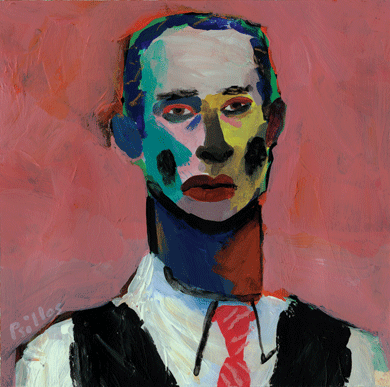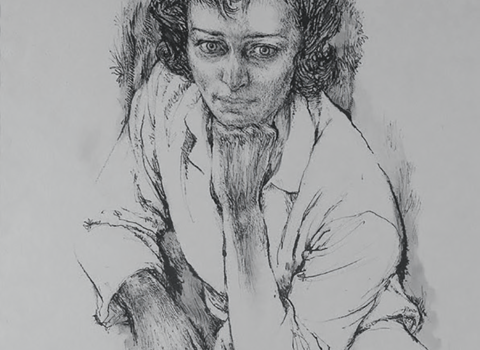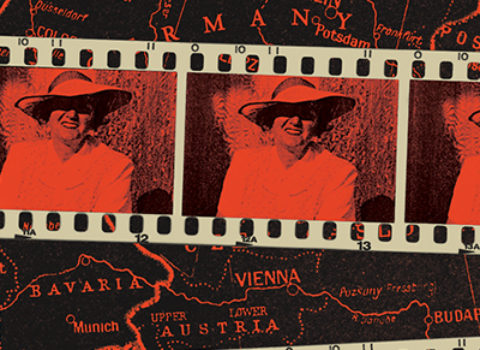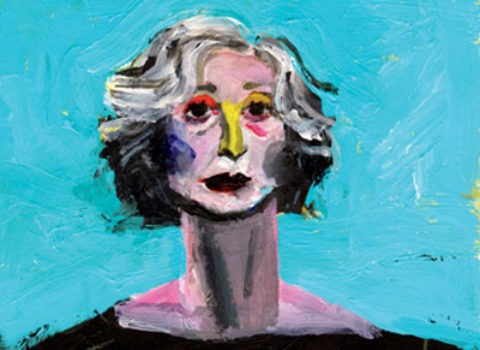Discussed in this essay:
E. E. Cummings: A Life, by Susan Cheever. Pantheon Books. 240 pages. $26.95.
E. E. Cummings: Complete Poems, 1904–1962, edited by George James Firmage. Liveright. 1,136 pages. $50.
I cannot be the only member of my generation who was introduced to E. E. Cummings by Woody Allen. The poet has a cameo in Hannah and Her Sisters, when Elliot, the buttoned-up British businessman played by Michael Caine, is attempting to woo Lee (Barbara Hershey), the most bohemian and romantic of the characters — and the sister of his wife. Running into her accidentally-on-purpose on the gritty SoHo block where she lives, he asks, somewhat absurdly, if there is a bookstore nearby, and she takes him to a crowded secondhand shop. As “Bewitched, Bothered, and Bewildered” plays in the background, Elliot takes an edition of Cummings’s poetry from the shelf and tells Lee he wants to buy it for her. The poem on page 112 reminds him of her — perhaps they could discuss it sometime? It’s the one that ends with the line “nobody,not even the rain,has such small hands,” and as Lee reads it in bed that night, she realizes Elliot is in love with her.
When Hannah and Her Sisters came out, I was twelve — a little young for Woody Allen, but the perfect age to discover E. E. Cummings. With his refusal to play by grammatical rules, his shameless sentimentality, his sexual frankness, and his easy quotability, he is the ideal poet of youth. The poet Harvey Shapiro, who for years was one of Cummings’s neighbors on Patchin Place in Greenwich Village, reported that young women would appear in front of the building “at all hours,” reciting poems and leaving flowers. Susan Cheever, in her thoughtful new biography of Cummings, recalls the poet’s visit to the prim girls’ school she attended, and his hilarious send-up afterward of the stuffy administrators. Anatole Broyard, the onetime New York Times book critic, wrote of saving up his money as a teenager to buy Tulips & Chimneys, Cummings’s first collection of poetry. I, too, remember spending my babysitting earnings on Cummings paperbacks; and I still have in my possession a hardcover edition of his Poems, 1923–1954 that appears to have been pilfered from my school library.
One can only imagine how many suitors, in the ninety years since Tulips & Chimneys first appeared, have appropriated the poems for their own declarations of love. Like Elliot, they must take care to get the page number right, because the Cummings oeuvre is something of a minefield. What might Lee have thought had she stumbled first on the graphic description of lovemaking that begins with “her careful distinct sex” (Cummings never gave his poems titles) and ends with orgasm? Or the justifiably notorious “a kike is the most dangerous / machine as yet invented,” which polluted Cummings with an odor of anti-Semitism that has never fully dissipated? Or a dark, late meditation such as “this is a rubbish of human rind,” which concludes with the mysterious lines “and the eyes of his eyes / are as lost as you’ll find”? The innocent reader who knows only the sap-sticky Cummings of greeting cards and wedding toasts (“I’d rather learn from one bird how to sing / than teach ten thousand stars how not to dance”) will be taken aback by both the variety of his forms and the nihilistic rage that, toward the end of his life, he indulged more and more.
Elliot’s suggestion that he and Lee “discuss” the poem is surely intended as a lame effort to disguise his true intentions. He wants to fall into bed with her, not conduct a seminar. Yet the joke is on him, because the critical establishment has been asking for years whether there is in fact anything to discuss in Cummings’s work. Broyard, describing how he and many other readers of his generation grew out of their love for Cummings, likens his disillusionment to a literary “puberty rite”: “One day the elders in the tribe inflicted painful scars on us and we were no longer boys, but men who were not allowed to play games with Mr. Cummings” and instead “pitched our tents in the wasteland of T. S. Eliot.” Cummings was not taken seriously by the poetry establishment until his Collected Poems was published, in 1938, fifteen years after his first collection; and no sooner was he admitted to the canon than his detractors began trying to pry him out of it. The critic R. P. Blackmur mocked Cummings’s overreliance on certain sentimental words (“flower,” Blackmur pointed out, appears in Tulips & Chimneys forty-eight times) and disparaged his “special use of language” as “baby-talk.” Randall Jarrell, reviewing Poems: 1923–1954 for The New York Times Book Review, called Cummings “a magical but shallow rhetorician.” Helen Vendler has described him as “a phenomenon — an interesting writer, a bad writer, a popular writer, a self-deceiving writer.” As Cheever acknowledges, he has become “better known for abjuring uppercase letters than for his poems.”
Cheever has set out to rescue Cummings’s reputation. She argues that he is “this country’s only true modernist poet” and compares his critics to the audience members who walked out on the Paris premiere of Stravinsky’s Rite of Spring or the exhibition-goers who raged at the art of Marcel Duchamp. His typographic experiments were intended to do more than make “poetic art out of commas and parentheses,” as his New York Times obituary put it; rather, Cheever argues, they represented his “wildly ambitious attempt at creating a new way of seeing the world through language.” And Liveright, Cummings’s longtime publisher, backs Cheever up with a handsome new edition of the Complete Poems that corrects typographic errors introduced by the original typesetters and includes several batches of previously hard-to-find work, mostly juvenilia.
It’s a treatment fit for a major poet, though the book’s editor, George J. Firmage, pointedly avoids making such claims on Cummings’s behalf. There’s no introduction — the poetry is left to speak for itself — and the jacket copy states modestly that Cummings was “among the most influential, widely read, and revered modernist poets.” His previous biographers (Cheever, depending on how you count, is either the third or the fourth) have been equally circumspect. Richard S. Kennedy, the author of Dreams in the Mirror — which appeared in 1980 and is still the definitive take on the poet’s life — declines to vouch for Cummings’s greatness, preferring to call him “unique” and “one of the leading American poets of the twentieth century.” Christopher Sawyer-Lauçanno, whose 2004 E. E. Cummings: A Biography incorporated material from previously restricted papers but (as Wyatt Mason pointed out in these pages) was so derivative of Kennedy’s book as to plagiarize it, also speaks of Cummings’s “unique voice” and quotes Marianne Moore’s rather oblique description of him as “a concentrate of titanic significances.” (A third biographical work, E. E. Cummings: The Magic-Maker, by the poet’s friend Charles Norman, is more of a memoir of Cummings’s life.)
What does Cheever bring to this rather crowded table? First, that bold assertion that Cummings is America’s “only true modernist poet,” which unfortunately is never fully defended. (What about Ezra Pound? William Carlos Williams? Wallace Stevens? T. S. Eliot?) Next, her literary pedigree: her father, John Cheever, was a friend of the poet’s, and she writes at the start of her book that, thanks to him, she grew up “steeped in Cummings stories that few people had heard.” Yet her biography largely follows the territory already trampled by her predecessors. With the exception of the first chapter, a wonderfully written set piece describing Cummings’s 1952 Norton Lectures, there seems to be little in the way of new material here. But her streamlined approach will appeal to Cummings enthusiasts who find it difficult to get through Kennedy’s and Sawyer-Lauçanno’s much weightier tomes. And she writes with fine psychological insight about the interpersonal muck in which the poet found himself continually mired, particularly his difficult relationships with women.
Cummings was born in 1894 in Cambridge, Massachusetts, to highly educated and privileged parents. His father was a minister who also taught sociology at Harvard; his mother encouraged her son’s writing and recorded every detail of his upbringing in her diary. Summers were spent at Joy Farm, the family place on New Hampshire’s Silver Lake, which was apparently as idyllic as it sounds. Though he would later write satirically of “the Cambridge ladies who live in furnished souls,” as a child Cummings soaked up every drop of this cultured atmosphere. It was from Josiah Royce, chair of the Harvard Department of Philosophy, that he first heard the sonnets of Dante Gabriel Rossetti, an experience that left him with a lifelong obsession with the form.
The pleasantness of his childhood seems to have been marred by only one serious trauma. The summer Cummings was sixteen, he and his sister, Elizabeth, went out one evening in a canoe, taking their beloved dog, Rex. When Rex snapped at a hornet, the canoe capsized and sank, leaving the siblings clinging to the boxes they had been using for seats. In his panic, Rex climbed on Elizabeth’s shoulders and pushed her underwater. To save his sister, Cummings held the dog beneath the surface till he drowned.
Cheever speculates that this painful incident may have planted the seeds of Cummings’s rebellion, which began after he entered Harvard. His rigorous classical education had given him a solid grounding in poetic form, with which he would experiment throughout his career. “He knew the rules so well he could break them in fresh and imaginative ways,” Cheever writes. In college, he encountered the work of Ezra Pound, who first inspired him to use language in nonstandard patterns: he began deploying capital letters and punctuation for emphasis rather than meaning, reproducing everyday conversation in his poems, playing with the patterns his words created on the blank page, and even trying reverse lettering. Another important early influence was contemporary art from Europe. When the International Exhibition of Modern Art arrived in Boston in 1913 after its succès de scandale at the New York Armory, Cummings went to see it. The show, which featured Duchamp’s Nude Descending a Staircase as well as works by Gauguin, Matisse, Brancusi, and other experimental artists, is largely credited with introducing Cubism to the American public. Instead of representing a single, static moment, Cheever writes, Duchamp’s work represents “a whole series of moments in a series of modernistic forms. . . . A poem could do the same thing.”
What was Cummings trying to accomplish with his formal innovations? Cheever presents three main “tenets” of modernism: the use of words for sound instead of meaning, the stripping out of extraneous details so as to highlight form and structure, and the embrace of difficulty. But her claim that the modernist impulse was to “slow down the seemingly inexorable rush of the world” seems debatable; rather, the arts were rushing to catch up. That frenetic energy is visible everywhere in Cummings’s early poems, which include some of his best-known works — the tumble of “Buffalo Bill ’s / defunct,” with its compressed speed (“and break onetwothreefourfive pigeonsjustlikethat”), or the bounce and skip of “in Just- / spring”:
when the world is puddle-wonderful
the queer
old balloonman whistles
far and wee
and bettyandisbel come dancing
In Dreams in the Mirror, Kennedy reproduces that poem in an early form, with regular punctuation and line breaks: it is astonishingly ordinary. The arrangement on the page generates nearly all its power.
Even as he pushed the boundaries of poetic structure, Cummings remained fascinated by the traditional sonnet; Cheever says it was his favorite form. Tulips & Chimneys (1923) includes sixty-three, and they dominate his next book, & [And] (1925). Cummings delighted in placing new subjects into this old-fashioned setting. In one early series, a conventional Elizabethan sonnet mourning lost love is followed by another, just as conventional in form, describing sex:
—but the lunge of Her hunger softly flung
over the gasping shores
leaves his smile wan,
and his blood stopped hears in the frail anon
the shovings and the lovings of Her tongue
Another tells of “ ‘kitty’. sixteen,5?1?,white,prostitute.” A few years later, in is 5 (1926), Cummings’s experimentation had expanded to the form itself:
if i have made,my lady,intricate
imperfect various things chiefly which wrong
your eyes(frailer than most deep dreams are frail)
songs less firm than your body’s whitest song
upon my mind — if i have failed to snare
the glance too shy — if through my singing slips
the very skilful strangeness of your smile
the keen primeval silence of your hair
—let the world say “his most wise music stole
nothing from death” —
you only will create
(who are so perfectly alive)my shame:
lady through whose profound and fragile lips
the sweet small clumsy feet of April cameinto the ragged meadow of my soul.
One of the “intricate / imperfect various things,” of course, is the poem, with its ambiguous structure full of partial rhymes and variable rhythms. The unity of form and subject is every bit as complete as in “in Just- / spring,” yet the technique is entirely different. But how are we to reconcile Cummings’s attraction to both the freest of free verse and the restrictive form? If Cheever has thoughts about this, she does not share them. Often she simply reprints a poem in full and abandons it on the page, leaving her readers to draw their own conclusions.
Cummings moved to Greenwich Village in 1916, shortly after his graduation from Harvard. The neighborhood, Cheever writes, was “everything he hoped it would be,” filled with writers: Edna St. Vincent Millay, John Dos Passos, Eugene O’Neill, Theodore Dreiser, Edmund Wilson, Hart Crane. He lived there for forty-four years, through three marriages, two divorces, one child, and twelve books of poetry. Did this geographic stasis correspond to a creative stasis? After his initial innovations — the lowercase letters, idiosyncratic punctuation, and abundant line breaks that would be so widely imitated — Cummings ceased to alter his style. He had found something that worked for him, and he stuck with it. As Jarrell wrote, “He invents a master-stroke, figures out the formula for it, and repeats it fifty times.”
His subject matter, however, did evolve. Two important incidents shaped his iconoclastic politics. In 1917, to escape the draft, Cummings (like many other Americans) volunteered to drive ambulances in France. Somehow he and a friend took an extended detour through Paris on the way; after a few months of happy adventures with French prostitutes, Cummings was charged with treason for his refusal to avow his hatred of the Germans when asked to do so by the French authorities. He was imprisoned for several months at the Dépôt de Triage at La Ferté-Macé, a detention camp. In The Enormous Room, his autobiographical novel about the experience, Cummings plays up the absurdity of his situation and the colorfulness of the characters he encountered while in prison, most of whom claim, like the poet, to have wound up there by accident. Cheever points out that Cummings, who began using the lowercase i to represent himself in his poetry around this time, saw himself as an advocate for the “little man” — the people whose rights are trampled by the circumstances of war.
Later this attitude would get him into trouble of a different sort. Visiting the Soviet Union in 1931, Cummings was taken aback by the poverty and repression he witnessed. Asked by a reporter on his return whether the Russian people were happy, he responded, “They struck me like this: they just love to suffer and they’re suffering like hell, so they must be happy.” In a preface to Eimi, his impressionistic chronicle of the trip, he called the Soviet Union a “subhuman communist superstate,where men are shadows & women are nonmen.” History, of course, has proved Cummings right: Stalin’s purges began only a few years after his visit. But at the time, most of the writers in his circle were communist supporters, at least in theory. Cheever writes that he lost friends over the book, which was criticized for both its politics and its stream-of-consciousness style. Malcolm Cowley and Edmund Wilson, both onetime friends, excoriated him.
Cummings’s next book of poetry was turned down by fourteen publishers; he finally self-published it in 1935 as No Thanks. His politics almost certainly played a role in the book’s rejection. But its obscenity may also have been a factor. The singsong “may i feel said he” has become one of Cummings’s most infamous poems:
may i feel said he
(i’ll squeal said she
just once said he)
it’s fun said she
And so on through eight stanzas. Again Cheever quotes the poem in full virtually without comment, other than to call it “one of his most lighthearted poems about men and women.” But is it truly so lighthearted? The first lines suggest a questionable approach to seduction. And the ending reveals the woman’s role as essentially entrapping:
you’re divine!said he
(you are Mine said she)
This poem was written toward the beginning of Cummings’s relationship with Marion Morehouse, who would become his third wife. His first two marriages had been disasters. Elaine Orr Thayer, his first wife, had remarried and moved to Ireland with their daughter, Nancy, whom Cummings would not see again for twenty-two years. When he married Anne Barton, in 1929, Edmund Wilson reported that both the bride and the groom “had been stewed for days”; the marriage ended within a few years, owing to her infidelity. Cheever presents Cummings as a tenderhearted lover of women who was psychologically crushed by his mistreatment by his first two wives. Still, one has to wonder whether his obsessive celebration of the female body conceals a deeper desire to control. It seems clear that part of the reason for his happy relations with Morehouse was that she did not challenge him intellectually. (Significantly younger than Cummings and a professional model, she probably had not finished high school.) In an account of an early meeting with her, he writes of himself in the second person:
you were soaring along in your natural way — & she looked at you imploringly; as if to say “please! Don’t be intellectual with me: I’m just a woman!” whereupon you came down to earth . . . &have been there ever since.
In the 1930s and 1940s, Cummings’s politics continued to turn right: he liked to refer to the New Deal as the “nude eel.” More problematically, he stayed loyal to Pound even after his old friend was condemned for his anti-Semitic radio broadcasts during World War II. In addition to the “kike” poem, Cummings’s collection Xaipe (pronounced “kai-ray”), published in 1950, includes “one day a nigger,” a two-stanza fairy tale about a black man who catches hold of a star and demands that it make him white. Though Cheever calls Cummings an “equal-opportunity hater” and acknowledges that Marion Morehouse was “mindlessly, socially anti-Semitic,” she argues repeatedly that the poet must be judged by the standards of his own time, not by ours. By any standards, the ugliness cannot be overlooked, although Cheever also cannot be blamed for failing to reconcile the Cummings of birdsong and stars and love and carnality with the spouter of hatred.
There is a religious component to Cummings’s work that this biography does not address and that goes further than the nature-worshipping commonly attributed to him. Cummings was, after all, the son of a minister; and there are poems in Xaipe (which is the Greek word for “rejoice” and also happens to be the Angel Gabriel’s greeting to Mary at the Annunciation) that speak with the voice of prayer. Poem number fifty, “walking in the dark / i met christ,” describes a kind of vision. Or consider this late sonnet:
i thank You God for most this amazing
day:for the leaping greenly spirits of trees
and a blue true dream of sky;and for everything
which is natural which is infinite which is yes(i who have died am alive again today,
and this is the sun’s birthday;this is the birth
day of life and of love and wings:and of the gay
great happening illimitably earth)how should tasting touching hearing seeing
breathing any — lifted from the no
of all nothing — human merely being
doubt unimaginable You?(now the ears of my ears awake and
now the eyes of my eyes are opened)
Compared with “if i have made,my lady,intricate,” the rhymes are less precise, more free-flowing; the rhythm races in a fervor through the third stanza till it lands on the climactic “You.” Then a hush falls on the murmured final couplet. The image is one of spiritual rebirth, certainly, but also perhaps of creative awakening to perfect receptivity, the opening of the inner senses to the outside world.
The sonnet does not follow the traditional logic of religious poetry, in which the poet ultimately puts his talents in the service of celebrating God’s creation. Rather, Cummings implies a union between himself and the divine — “i who have died am alive again today” — that hints at the arrogance for which his critics have often faulted him. The literary critic George Stade wrote that Cummings’s “self-confidence, his complacency even, was such as to inspire awe.” Unlike Gerard Manley Hopkins, whose religious sonnets are an obvious antecedent, Cummings seems to have viewed his art as primarily an expression of his own individuality, not as a mode of religious devotion or a means of bringing about political change. “From my standpoint the only thing — if you’re some sort of artist — is to work a little harder than you can at being who you are,” he wrote to his daughter in response to her efforts at poetry.
Not surprisingly, Cummings also rejected criticism as an approach to poetry — his own or anyone else’s. In one of his Norton Lectures, he quoted Rilke: “Works of art are of an infinite loneliness and with nothing to be so little reached as with criticism. Only love can grasp and hold and fairly judge them.” But love is not meant to judge; it’s meant, at least in the prevailing culture today, to be unconditional and all-forgiving. God’s love is the only love that judges. The critic Harry Levin called Cummings’s line “birds sing sweeter than books tell how” the theme song for all his poetry: “in his terms . . . the vain attempt of books to emulate birds.” Of course, one would no sooner analyze a bird’s song than criticize the color scheme of the Grand Canyon.
Cummings carefully cultivated an image of accessibility. “The poems to come are for you and me and are not for mostpeople — it’s no use trying to pretend that mostpeople and ourselves are alike,” he wrote in the introduction to his Collected Poems, in 1938. “Mostpeople have less in common with ourselves than the squarerootofminusone. You and I are human beings;mostpeople are snobs. . . . With you I leave a remembrance of miracles:they are by somebody who can love and who shall be continually reborn.”
The effect is something like A. A. Milne crossed with C. S. Lewis: Winnie-the-Pooh goes to church. Its naïveté is contrived and cloying. But it is a shrewd way to appeal to the general reader — the person who, like Woody Allen’s Elliot, may never have read another poet in his life but can quote Cummings by heart. Forget about the critics! Cummings says. Just open your heart!
Of course, it worked. His detractors notwithstanding, Cummings was one of the most popular poets of the twentieth century. His influence has been so pervasive that it is unjustly easy to take his innovations for granted. Malcolm Cowley’s assessment still seems one of the wisest: “He is unsurpassed in his special field, one of the masters.” One can appreciate his contribution without magnifying it.









































































































